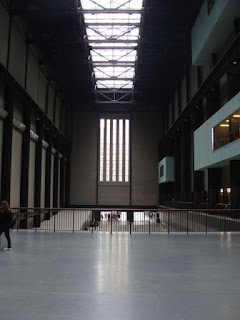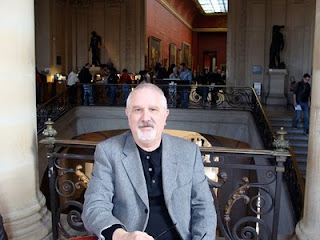Medallion of St, Katharine
I get up and rush down for breakfast. There is a young man sitting down there who very much looks like Jason Stratham – curious. A comment about the breakfasts at St. Katharine’s: it was always the same thing; Hardboiled eggs, industrial croissants or muffins, cereal, ham or coppa, bread for toasting, milk, apple juice, orange juice, coffee and tea. This was not bad, but when I think of the breakfasts that Arthur and I experienced in Budapest, Berlin, Istanbul, and Munich, this seems not bad, but not so good. There were very few people there, except for “Jason”, so I eat quickly and leave.
Before I head out I go over to take a few photographs of the chapel. They managed to save some nice things when the church was damaged in the war, and subsequently rebuilt.
The Fairy-fellers Master Stroke
My goal is to conquer the Tate Britain, but I am to be undone. The “industrial action” is over, and the galleries are open and full of people. It is a wonderful collection. One comment made in one of the galleries was that after the Reformation (which is generally downplayed in the Episcopal Church in the US) the painting of religious scenes was abandoned in favor of portraiture. Indeed that seems to make up the bulk of the historic collection at the Tate: Constable, Sergeant, Hogarth, and others. Also interesting was the comment that in Elizabethan times, the power of a portrait was judged by the ornamental surface (the dress, jewels, lace, etc.) and not the face. Those commissioning works demanded that particular attention was to be paid to these details.
All seems to be going well, until I get close to the rooms that I really want to see: High Victorian, Bloomsbury, and Pre-Raphaelite Painters. All of those galleries are closed for ceiling work! I am undone. So there is no seeing the Master Fairyfeller. I look in at the Turner Collection, which is huge, but have the same experience there that I had with the Joan Miro Museum in Barcelona – it is too much. Or, as my sisters, Bonnie and Wendy would say, “MEGO!” (My Eyes Glaze Over).
The modern holdings aren’t all that interesting. There was a gallery of Hockney, but I couldn’t find it and finally gave up. In the rotunda there was a group of around 25 college-aged people being very noisy and disruptive – and misanthropy was setting in. It was time to go. I walked by the restaurant, where many years ago I had a wonderful steak and kidney pie, Scottish raspberries, and Devonshire cream. No more! The menu looks like something straight out of Citizen Cake or Orson.
Tate to Tate Ferry
Rather than trudge back to Pimlico and transfer twice to get to the Tate Modern, I take their ferry service, for which I can use my Oyster Card. It’s a lovely trip. You go past Parliament, M16, Royal Festival Hall, the London Eye, Lambeth Palace, and all the Millennium stuff that London through up at the end of the century. It’s a quick trip and very relaxing. It is also indoors – which had much to say for it.
Turbine Hall at the Tate Modern
The Tate Modern is just amazing. I came in on the second floor, and just looked at the Turbine Hall for a second. What really caught my eye was an installation by Miroslaw Balka, a huge iron box (that could hold at least a hundred or more people) sitting at the east end of the hall. Fabulous! I go up to the seventh floor (the elevator had a moment where all on board thought that we were truly going to die) and have a nice lunch in the restaurant (roasted duck confit, with potato purée, onions roasted in balsamic vinegar, and cress. It was quite delicious. The views from the restaurant are quite compelling as well.
View of St. Paul’s from Tate Modern
What are enjoyable are the whimsical names that they give to the galleries. The progression is not by painter, genre, or chronology. In one room, for example, two Francis Bacon pieces were compared to two Picasso pieces. I thoroughly enjoyed what I saw, although I find Jeff Koons to be just annoying. There was some wonderful Beckmann and Rouault. Having worked my way down, it was now teatime; I stop at the restaurant on the 2nd floor and have an Apple-Sultana Crumble (tasteless) and tea.
I walk down the south Embankment past the (new) Old Globe, and past wonderful restaurants selling British food (savory pies, pies, pies – I think they’re wonderful!) and make my way over to Southwark Cathedral. There are two dioceses in London. London Diocese is north of the Thames, and Southwark is south. Getting there I pass a recently uncovered medieval ruin of an episcopal palace, and when I get to the cathedral, they have their own recent uncoverings as well. All of this was made possible by the Millennium stuff. When they built all those bridges, halls, and amusements, new excavations (and discoveries) were made.
Southwark Cathedral with Lenten Array
The cathedral was in the middle of a service celebrating their Senior School – so I had to wait. When I heard the organ thundering out Karg-Elert’s Now Thank we All our God, I knew it was time to go in. It is the oldest cathedral in London and has a very active parish, and, as one of the Stewards said to me, “has a very lived in feel.” I enjoyed my brief stay there. Lots of polychromed tombs, and side altars, each with their own Lenten Array, and riddle curtains.
Tombs at Temple Church
I’m getting a bit tired, but decide to make a stab at Temple Church, so I go to Temple Underground Station and make my way through the maze of law offices and find the church again. It was fun to see the elements that Ron Howard played on in The Da Vinci Code. In actuality, it was not all that threatened. I was going to take more photographs, when suddenly the young man at the door thundered, “The church closes at 4:00!” and out we all went. I went home to write.
That evening I had dinner at La Figa – which was my home away from home several nights. It is an Italian Restaurant, run by an Italian family. The waiters are all Italian. None of them however have any passion for the food, and it shows. It isn’t bad food, it’s just not inspired, and the people serving it aren’t passionate about it. I asked questions about two selections, and the waitress shrugged her shoulders. I started with what I thought would be something simple, an avocado with prawns, and what I got was an avocado with bay shrimp covered with enough mayonnaise to choke a horse. The lamb chops with rosemary were good, done medium rare. The vegetables and starch are the same for anything on the menu. I don’t get a dessert, but do talk with the owner on the way out. He had lived in Australia for a while, after leaving Italy. He asks where I am from, and I tell him. “Ah! San Francisco! Lots of really good Italian restaurants, I hear. I need to go there.” So do I. It is time to go home.





















































